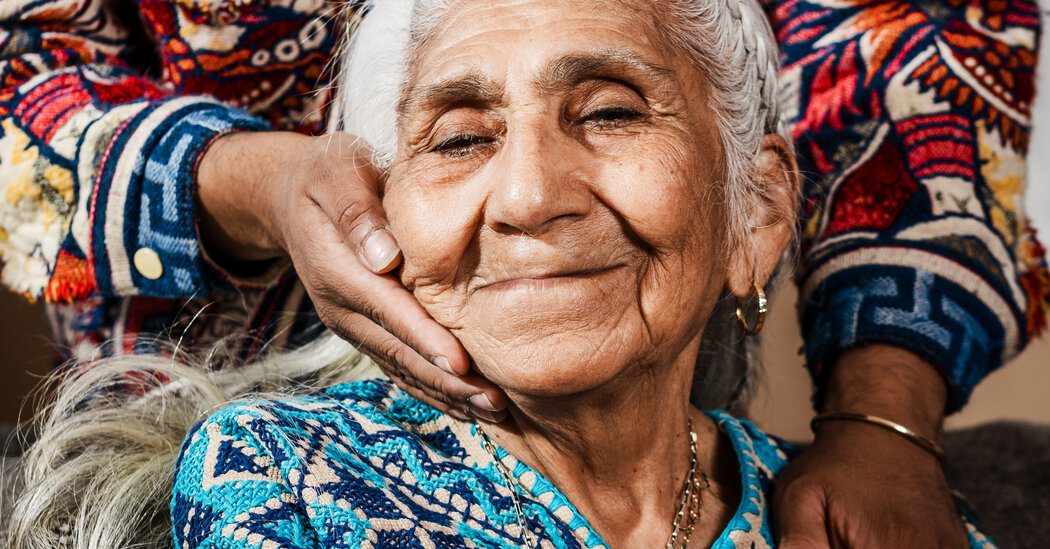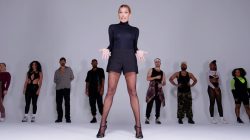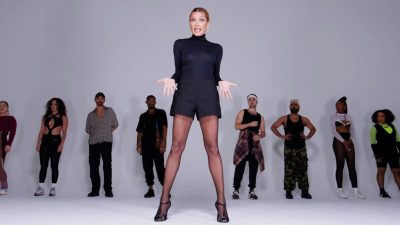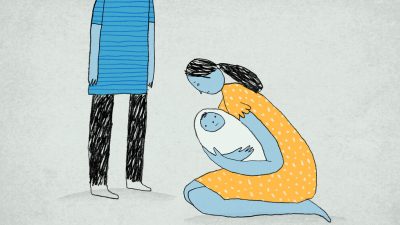On the east side of San Jose, Calif., there is an abuela who seems to have more grandchildren than she can count.
“A lot of people see me and they hug me,” Mardonia Galeana, 89, said in Spanish. “I don’t even know them, but sometimes they ask me for a blessing on the street and I do the best I can on their forehead.”
Her likeness has been featured in a painting in the San José Museum of Art and in a mural in the city’s mission district. But it’s her online presence that has captivated the thousands of people who have come across the photos and videos posted by her grandson Yosimar Reyes.
“Seeing your Abuela smiling and having a good time truly warms my heart,” one user commented beneath a video of Ms. Galeana enjoying herself at a senior center while others danced to a track by the merengue singer Elvis Crespo.
Mr. Reyes has been chronicling moments in his grandmother’s life on a private Instagram account followed by more than 21,000 people. His posts have shown a trip they took to New Orleans, their strolls with his dog, Chulito, around the San Jose Flea Market, and occasional doctor visits.
Although Mr. Reyes calls himself Ms. Galeana’s “personal stylist,” he is first and foremost her caregiver — driving her to appointments, managing her medications, making sure she has a roof over her head.
“I take pride in the fact that I care for and dress my grandma,” Mr. Reyes, 35, said. “That she’s not going to be out here in a muumuu. Her nails are also poppin’ and it’s a big self-esteem boost for her.”
Francesca Falzarano, an assistant professor at the University of Southern California Leonard Davis School of Gerontology, has a term for the growing number of people like Mr. Reyes who share behind-the-scenes looks at the daily realities of providing round-the-clock care for older loved ones.
“In my research lab, we call them ‘carefluencers,’” Professor Falzarano said. “Social media is really the only way a lot of these people are able to access support, education and a sense of belonging.”
Mr. Reyes, a poet and artist, was raised by his grandparents and came with them to the United States from Guerrero, Mexico, in the early 1990s. “Even as a kid, I was already a caregiver,” he said. “I had to translate documents and help my grandparents navigate this country because they were older and didn’t speak English.”
Mr. Reyes, who was named the 2024 Santa Clara County poet laureate, said he has occasionally found himself overwhelmed since he fully undertook the role of caring for his grandmother during the Covid-19 pandemic.
“I’m trying to build a career as an artist and as a writer, but then I still have to go home and have to take care of somebody,” said Mr. Reyes, who has described his experience as a caregiver in poems like “Abuela Gets a Fever.” “Some days, I’m emotionally depleted. And if she’s having a bad day, I have to make sure that I’m not reactionary.”
As the population ages, Mr. Reyes’s experience is likely to become more common. According to the Centers for Disease Control and Prevention, the number of unpaid caregivers in the United States increased to about 53 million in 2020 from 43.5 million in 2015.
Chris Punsalan of Las Vegas, who became a caregiver for his grandmother Anicia Manipon eight years ago, has shared his experiences with her on YouTube, Instagram and TikTok.
“I decided to document us because I felt it was important,” Mr. Punsalan, 30, said. “It’s not only for me to be able to look back on, but I also slowly realized that it was very helpful for people who have been through a somewhat similar situation.”
Mr. Punsalan, who has over two million followers on TikTok, has created content out of tending to his grandmother’s bedsores, cooking her breakfast and sharing the products he uses to tend to her needs. Since Ms. Manipon’s death in January, he realized that his social media accounts have done more than provide information and comfort for other family caregivers.
“During her funeral, my cousin said something that really struck a chord with me,” Mr. Punsalan recalled. “He said, ‘Whenever I miss my grandmother, I have a library of videos to remember her by.’”
Jacquelyn Revere, an aspiring TV writer in Los Angeles, began posting about her experiences became the main caregiver for her mother and grandmother in 2016. She said she found comfort while trying to help others in her position through social media, and the number of people following her on TikTok grew to more than 650,000.
“When I was posting my mom, it’s not like I felt like I had to — it actually became fun,” said Ms. Revere, 37. “Social media brought so much validation with people saying, ‘You’re doing such a good job,’ and it became a place of refuge.”
Ms. Revere’s grandmother died in 2017; her mother died in 2022.
“Many of my caregiver friends are people who I’ve met on social media,” Ms. Revere said. “We’ve really created a community that’s very close knit, because it’s hard to understand the weight of this role if you’ve never had it.”
While posting a get-ready-with-me-and-Grandma video on TikTok may bring caregivers a sense of community, some viewers can’t shake the feeling that such content might be exploitative. Is a vulnerable older relative in a position to consent to appear in a video, when the person recording it is responsible for administering her medication?
“That is so heartbreaking,” one user commented on a TikTok video of an older woman struggling to eat. “I wish you all would have the dignity to stop posting these messages.”
But according to Professor Falzarano, the gerontologist, the benefits of caregivers’ sharing their experiences outweigh the risks. “It’s really contributing to the greater awareness and visibility of chronic illness in caregiving,” she said.
Professor Falzarano, 32, whose research is focused on dementia, family caregiving and technology for older adults, also noted that while there are a variety of resources readily available for expecting parents, the same could not be necessarily said for those grappling with the end of life.
“We all have this universal experience where we’ll need to provide care or need to be cared for at some point,” Professor Falzarano said. “Why not start thinking about it now?”
Ms. Galeana, who will turn 90 in December, hasn’t been able to return to the home in Mexico that she and her grandson left behind more than three decades ago. With no clear pathway to U.S. citizenship, the two have built a forever home of sorts online.
“She’s old and she’s been through so much, from poverty in Mexico to all that we’ve experienced in the United States,” Mr. Reyes said. “My goal now is to make sure that she’s happy and not always talking about how sad her life was. And people love her here and know her as the abuelita. It’s beautiful.”
Whether it’s being recognized at the market or having flowers or care packages sent to her home by strangers who have encountered her online, she has become a local celebrity.
“As a little girl, I wanted to be an artist,” Ms. Galeana said in Spanish. “I would dance and sing and want to be on the movie theater screen. But it never happened.”
But later that week, after Mr. Reyes had fixed her hair and done her makeup, she was ready to be the star of a video that would be seen by thousands.
Sumber: www.nytimes.com












